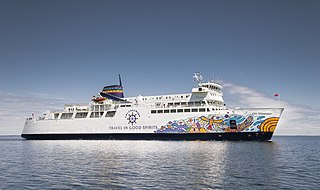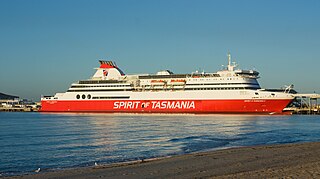A ferry is a boat that transports passengers, and occasionally vehicles and cargo, across a body of water. A small passenger ferry with multiple stops, like those in Venice, Italy, is sometimes referred to as a water taxi or water bus.

The SeaBus is a passenger-only ferry service in Metro Vancouver, British Columbia, Canada. It crosses Burrard Inlet to connect the cities of Vancouver and North Vancouver. Owned by TransLink and operated by the Coast Mountain Bus Company, the SeaBus forms an important part of the region's integrated public transportation system. In 2023, the SeaBus had a ridership of 5,127,000, or about 17,300 per weekday as of the third quarter of 2024.

MS Chi-Cheemaun is a Canadian passenger and vehicle ferry in Ontario, Canada, which traverses Lake Huron between Tobermory on the Bruce Peninsula and South Baymouth on Manitoulin Island. The ferry connects the two geographically separate portions of Highway 6 and is the vessel that replaced MS Norgoma and SS Norisle in 1974. The ferry service runs seasonally from mid-May to mid-October. As of 2022 she is the third largest passenger vessel sailing the Great Lakes after the expedition cruise liner Viking Octantis and the US ferry SS Badger, although several larger vessels previously serving the Great Lakes are still in service in other parts of the world.

Bay Ferries Limited, or simply, Bay Ferries, is a ferry company operating in eastern Canada and is headquartered in Charlottetown, Prince Edward Island, Canada. It is a subsidiary of Northumberland Ferries Limited and a sister company to the defunct Bay Ferries Great Lakes Limited.

Toronto Harbour or Toronto Bay is a natural bay on the north shore of Lake Ontario, in Toronto, Ontario, Canada. Today, the harbour is used primarily for recreational boating, including personal vessels and pleasure boats providing scenic or party cruises. Ferries travel from docks on the mainland to the Islands, and cargo ships deliver aggregates and raw sugar to industries located in the harbour. Historically, the harbour has been used for military vessels, passenger traffic and cargo traffic. Waterfront uses include residential, recreational, cultural, commercial and industrial sites.

The Toronto Port Authority (TPA), doing business as PortsToronto (PT), is a port authority that is responsible for the management of the Port of Toronto, including the International Marine Passenger Terminal, and Billy Bishop Toronto City Airport. It was established under the Canada Marine Act as a government business enterprise that is self-funded, with directors appointed by three levels of government – the Government of Canada, the Government of Ontario and the City of Toronto. The TPA rebranded itself as PortsToronto in 2015.

The Toronto Island ferries connect the Toronto Islands in Lake Ontario to the mainland of Toronto, Ontario, Canada. The main city-operated ferry services carry passengers (all) and commercial vehicles (some) from the Jack Layton Ferry Terminal at the foot of Bay Street to three docks on the islands. Private motor vehicles are not carried. The ferry operated by PortsToronto carries passengers and vehicles to Billy Bishop Toronto City Airport on the island from the foot of Eireann Quay. Additional private ferries carry passengers to various island boat clubs. Ferry services to the islands began in 1833, and the Toronto Island Ferry Company began in 1883.

Bay Ferries Great Lakes was a marketing name used by Bay Ferries Management Limited, a subsidiary of Northumberland Ferries Limited (NFL).

The Toronto Ferry Company was formed from the merger of the Doty Ferry Company with A.J. Tymon's Island Ferry Company, two of Toronto's early ferry operators to Toronto Islands in 1890. TFC was founded and headed by businessman Lol Solman, who owned several attractions on the Toronto Islands including Hanlan's Point Amusement Park, Hanlan's Point Stadium and the Hanlan's Hotel. The company's ferry license and ships as well as the amusement park and other assets were acquired by the Toronto Transportation Commission in 1927. On March 17, 2021, The Toronto Ferry Company Inc was registered under the Ontario Business Corporations Act to Michael A. McLaughlin.

Scotia Prince Cruises was a cruise ferry operator based in Maine which owned and operated the M/S Scotia Prince. This ferry operated across the Gulf of Maine between Portland, Maine, and Yarmouth, Nova Scotia, until the end of the 2004 sailing season.
Transportation in the Canadian city of Toronto forms the hub of the road, rail and air networks in the Greater Toronto Area and much of southern Ontario. There are many forms of transport in the city, including railways, highways, and public transit. Toronto also has an extensive network of bicycle lanes and multi-use trails and paths.

TT-Line Company Pty Ltd, trading as Spirit of Tasmania, is a Tasmanian Government-owned business that has been offering ferry services between mainland Australia and Tasmania since July 1993. Navigating the Bass Strait, Spirit of Tasmania ferry services cover a distance of 242 nautical miles between Geelong, Victoria and Devonport, Tasmania. Each journey across the "Sea Highway" takes approximately 9–11 hours in both directions.

The Owen Sound Transportation Company Limited is a Crown agency of the Government of Ontario responsible for operating seasonal ferry services within Ontario. The agency is based in Owen Sound and was established in 1921 as a private company until it was fully acquired by the Government of Ontario in 1973. The agency operates the M.S. Chi-Cheemaun between Tobermory and South Baymouth; the M.V. Niska I between Moosonee and Moose Factory Island; and the M.V. Pelee Islander, M.V. Pelee Islander II, and M.V. Jiimaan between Kingsville/Leamington and Pelee Island. The M.V. Pelee Islander is also operated between Pelee Island and Sandusky, Ohio.

The Port of Toronto is an inland port on the northwest shoreline of Lake Ontario in Toronto, Ontario, Canada. The port covers over 21 hectares of land on the eastern shore of the Toronto Harbour, in an area known as the Port Lands. The port includes several facilities, including Marine Terminal 51, Warehouse 52, and the International Marine Passenger Terminal. The Port of Toronto is operated by PortsToronto.

The history of commercial passenger shipping on the Great Lakes is long but uneven. It reached its zenith between the mid-19th century and the 1950s. As early as 1844, palace steamers carried passengers and cargo around the Great Lakes. By 1900, fleets of relatively luxurious passenger steamers plied the waters of the lower lakes, especially the major industrial centres of Chicago, Milwaukee, Detroit, Cleveland, Buffalo, and Toronto.

The HSC Virgen de Coromoto is an 86 m (282 ft) fast catamaran ferry operated by Consolidada de Ferrys C.A. in Venezuela. It was built in Australia in 2004 for a fast ferry service on Lake Ontario between Toronto, Ontario, Canada and Rochester, New York, United States. After the ferry service failed, the boat was sold in 2007 and operated in the Strait of Gibraltar on a Spain-Morocco service until 2012. In 2012–13, the ship operated on Kattegatruten's Aarhus–Kalundborg route in Denmark until October 2013 when the route was cancelled.

MV Princess of Acadia was a roll-on/roll-off passenger and motor vehicle ferry that traveled between Digby, Nova Scotia and Saint John, New Brunswick, crossing the Bay of Fundy. The vessel held 650 passengers and could transport 180 automobile equivalents. On July 28, 2015 the ship was replaced by MV Fundy Rose.
Hornblower Cruises is a San Francisco–based charter yacht, dining cruise and ferry service company. In 2021, the company rebranded most of its services as City Cruises or City Experiences. In 2024, the company filed for bankruptcy protection.

International Marine Passenger Terminal is a cruise ship passenger terminal located in the Port of Toronto at 8 Unwin Avenue in Port Lands, Toronto, Ontario, Canada. The facility is operated by PortsToronto.

Sam McBride is a Toronto Island ferry operated by the Parks, Forestry and Recreation Division of the City of Toronto government. The ferry serves the Toronto Islands from a dock at Jack Layton Ferry Terminal in downtown Toronto, Ontario, Canada.

















